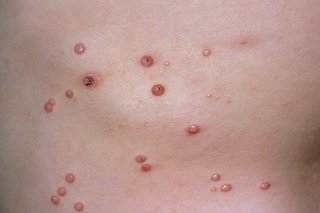Molluscum contagiosum (MC) is a viral infection that affects the skin. Around 9 out of 10 cases happen in children although it can occur at any age.
MC is generally a harmless condition that normally gets better in a few months without any specific treatment.
However, it's common for the condition to spread around the body, so it can take up to 18 months or more for the condition to clear completely.
Symptoms of molluscum contagiosum (MC)
Usually, the only symptom of MC is a number of small, firm, raised papules (spots) on the skin with a characteristic small dimple in the middle. The spots are not painful, but can be itchy.
The spots may develop in small clusters and can be spread across different parts of the body. They're most often found in the armpit, behind the knees or on the groin.
MC can affect a person on more than 1 occasion, but this is uncommon.

DR P. MARAZZI/SCIENCE PHOTO LIBRARY
When to seek medical advice
See a GP if you notice the spots associated with MC. They're usually easy to recognise, so they should be able to diagnose the condition without the need for further tests.
If the GP thinks the infection may be caused by something other than MC, they may want to:
- take a skin sample (biopsy) from one of the spots to test it for the molluscum contagiosum virus (MCV)
- refer you to a genitourinary medicine (GUM) clinic to be tested for sexually transmitted infections (STIs) – if you prefer, you can go to an STI clinic directly
They may refer you to a specialist in hospital if you have:
- spots on your eyelids, near your eye, or your eye is red or painful
- HIV and your symptoms are severe
- a weakened immune system for another reason – such as receiving chemotherapy
Causes of molluscum contagiosum (MC)
MC is caused by a virus known as the molluscum contagiosum virus (MCV).
This virus can be spread through:
- close direct contact – such as touching the skin of an infected person
- touching contaminated objects – such as towels, flannels, toys and clothes
- sexual contact – this includes intimate physical contact as well as sexual intercourse
If you become infected by the virus and spots appear on your skin, the virus can also spread to other areas.
It's not known exactly how long someone with MC is contagious for, but it's thought the contagious period may last up until the last spot has disappeared.
Treating molluscum contagiosum (MC)
Routine treatment for MC, particularly in children, is generally not recommended because:
- the infection usually clears up on its own
- the infection does not normally cause any symptoms other than the spots
- the infection does not usually interfere with everyday activities, such as going to work, swimming or playing sports
- treatments can be mildly painful and may cause scarring or damage to the surrounding skin
Treatment is usually only recommended for older children and adults when the spots are particularly unsightly and affect quality of life, or for people with weakened immune systems.
In such cases, treatments that may be offered include:
- liquids, gels or creams that are applied directly to the skin
- minor procedures such as cryotherapy (where the spots are removed by freezing them)
Preventing the spread of molluscum contagiosum (MC)
Although MC is infectious, the chance of passing it on to others during normal activities is small.
It's not necessary for you to stay away from work or your child to stay away from school or nursery, or to stop doing activities such as swimming if you have MC.
However, you should take some steps to avoid spreading the virus to other people. You should:
- avoid sharing towels, flannels and clothing
- avoid squeezing or scratching the spots – as well as increasing the risk of the infection spreading, this can cause pain, bleeding and can lead to scarring
- keep affected areas of skin covered with clothing whenever possible – a waterproof bandage can be put over the area if you go swimming
- avoid sharing baths
Using a condom while having sex can reduce the risk of passing on MC during sexual contact.
Complications of molluscum contagiosum (MC)
MC rarely causes any other problems but complications can occasionally occur. These include:
- the spots may become infected by bacteria – which may require treatment with antibiotics
- scarring – after MC has healed and cleared, small patches of paler skin or tiny indented scars may be left behind; this is more likely if the spots became infected or after treatment
- eye problems – a secondary eye infection may develop, such as conjunctivitis or keratitis, which may cause your eyes to become sore and sensitive to light
See a GP if you suspect a bacterial infection or experience any eye problems such as eye pain or redness. Signs of a bacterial infection can include redness, swelling and pain in the skin and underlying tissue.
Page last reviewed: 6 February 2020
Next review due: 6 February 2023
